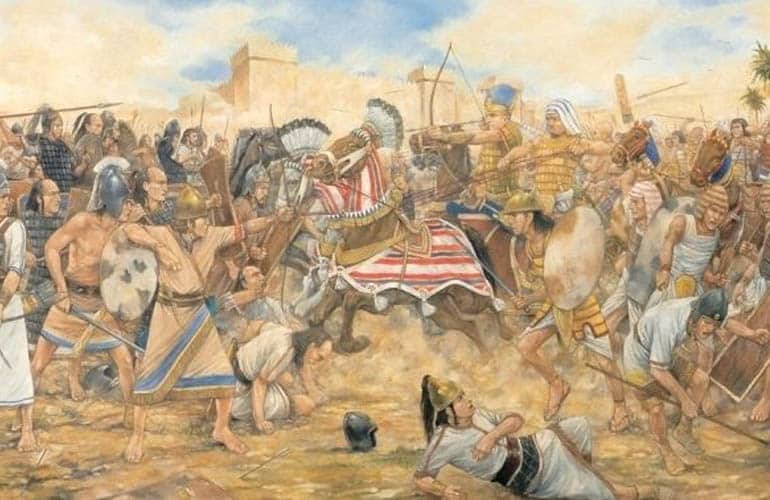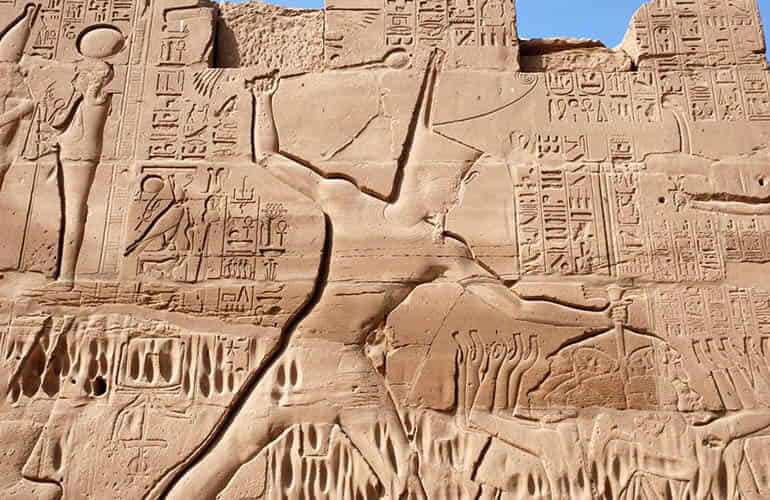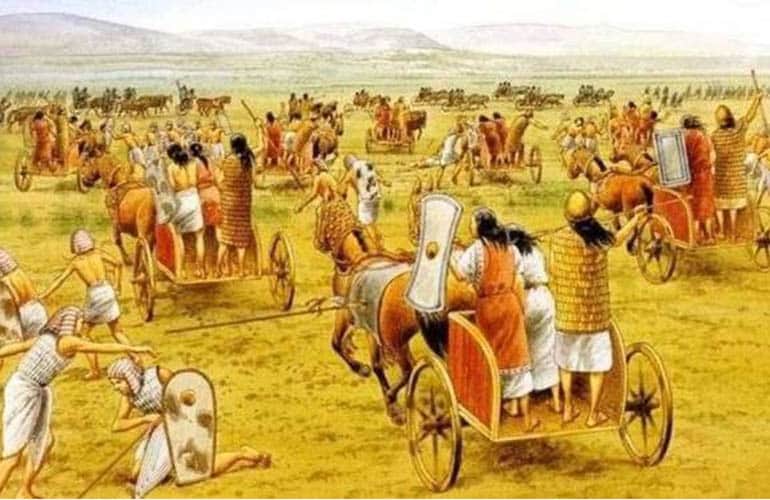Battle of Megiddo, Ancient Egypt:
The battle of Megiddo is the first battle to be recorded in full detail in ancient history, after the death of Queen Hatshepsut in 1468 BC, the young Pharaoh Thutmose III occupied the throne.
the kings of Megiddo and Kadesh rebelled against Thutmose III on the head of one hundred and fifty rulers. They gathered the biggest army known to date in this territory and established their base of operations in the city of Megiddo, given its great strategic importance because it was a place of passage for the commercial routes that went both to Egypt and to Mitanni. It is estimated that this alliance had between 15,000 and 20,000 men, as well as 1,000 chariots of war.

Thutmose III at The Battle of Megiddo
In 1457 BC, Thutmose III assembled an army of over 20,000 men and about 1,000 chariots, possibly simulating that of Ramses II in Kadesh, among which were the elite corps of the Egyptian army, the Nubians, specialists in the use of the composite bow which for the first time has written reference to its use. This force meets at the Tjaru fortress. The pharaoh decides not to wait for the prince of Kadesh and his army to advance towards Egypt but to go ahead and attack them on their own ground, besieging Megiddo, which is 300 kilometers away. To get there meant crossing the deserts of Sinai and Gaza so it was necessary to carry sufficient supplies of water and food, more than fourteen tons of grain and twenty-five thousand tons of water that were loaded in transport carts possibly pulled by oxen and the water in sealed clay jars to prevent it from spilling on the way.
The march of Thutmose’s army was along the so-called Horus Road, which connected Egypt with Asia, and would lead them to Gaza. In just ten days the army travels 250 kilometers, more than 25 kilometers a day, but tiredness and heat are slowing down the army’s march, which will take three weeks to reach Yehem, northwest of the Dead Sea, near the Mediterranean coast and the last stop before reaching Megiddo.

Megiddo War strategy
Thutmose III meets with his officers to decide the way forward, two of them, the north and south, allow easy access to Megiddo but are longer, while the third via through the pass the narrow Aruna mountain pass (Wadi Ara), shorter and faster than the others but much more dangerous, as they would have to cross a narrow pass where the Egyptian army would be forced to walk almost in single file and would be an easy prey for an ambush from the heights. Of course, he would have to dismount the wagons and carry them on the backs of the horses.
Against the opinion of his officers, Thutmose III chooses the pass of Aruna (Wadi Ara) discarding the other two alternatives since he intends to reach Megiddo as soon as possible and take the enemy by surprise. The generals try to dissuade the pharaoh, believing that he is leading the army to its doom.
The Egyptian army goes through the narrow pass, in single file, that is to say, one soldier after another. It would take a whole day to cover the whole valley. By the time the vanguard peeked out of the other end of the gorge, the rear guard would not even have entered it. Around noon the first Pharaoh’s troops emerged from the narrow gorge and formed a fence to protect those who continued to leave. It took seven hours for the entire army to pass through the narrow valley. That night the Egyptians camped south of Megiddo, separated from the city by the Kina River.
On May 15, the pharaoh and his army finally crossed the Kina River and deployed in three groups west of the city in a concave fashion and the same in the center of the battle line, leading the battle.
The two armies go into battle, the Egyptians with their young pharaoh at the front, aboard their golden chariot that leads the central part of the front while their army takes on a concave shape that extends along the sides towards the enemy threatening to surround them. The strategy of the pharaoh and the thrust of the Egyptians driven by their leader overcome the resistance of the men from Kadesh who break formation and retreat in disorder towards Megiddo. If Thutmose’s men had continued the attack the battle would have ended right there with the capture of the city, but instead, they stopped to plunder the rebel camp and the rebel bodies since it was the only way for an ordinary soldier to get rich, losing the opportunity to take advantage of the disorder of the rebels to capture them, giving them time to retreat towards the city. The Pharaoh was enraged at the sight of this scene, but nothing could be done, except to degrade the generals who had been unable to control their men.

Consequences of the Battle of Megiddo
After this first campaign, Egypt once again established itself as one of the region’s great powers. The successive expeditions that Thutmose III carried out in the region in the following years were mainly of a collecting nature so that they did not forget to which great power they owed loyalty. Even in the reign of his successor, Amenhotep II (1427 – 1400 BC), the incursions were more about reaffirmation than conquest.
Later, when both the Egyptian border and the Mitanni border were threatened by a common enemy, the Hittites empire, the old enemies came to an agreement: Aleppo, Niya, and Nukhashe would go to Mitanni, and Qadesh, Ugarit, Tunip and other southern cities would go to Egypt.
On the other hand, after paying homage to him as victor and lord of the territory, the rebel cities provided Thutmose III with a booty of outstanding dimensions, collected in detail in the Annals of Thutmose III. It included about 900 chariots (including two gold-lined ones), about 200 armors (including the bronze ones of the rulers of Megiddo and Qadesh), about 2,500 horses, more than 25,000 different animals…
In addition, in this first campaign and in the following ones, Thutmose III also brought samples of the flora of Palestine, All these presents received were presented in the temple of Karnak to Amon, deity that would have allowed the Egyptian victory. Therefore, we can say that at this moment, the situation for Egypt is unbeatable. After the last Syrian military campaign of Thutmose III in 1435 BC, a period of twenty years of peace awaited the Nile Empire.






